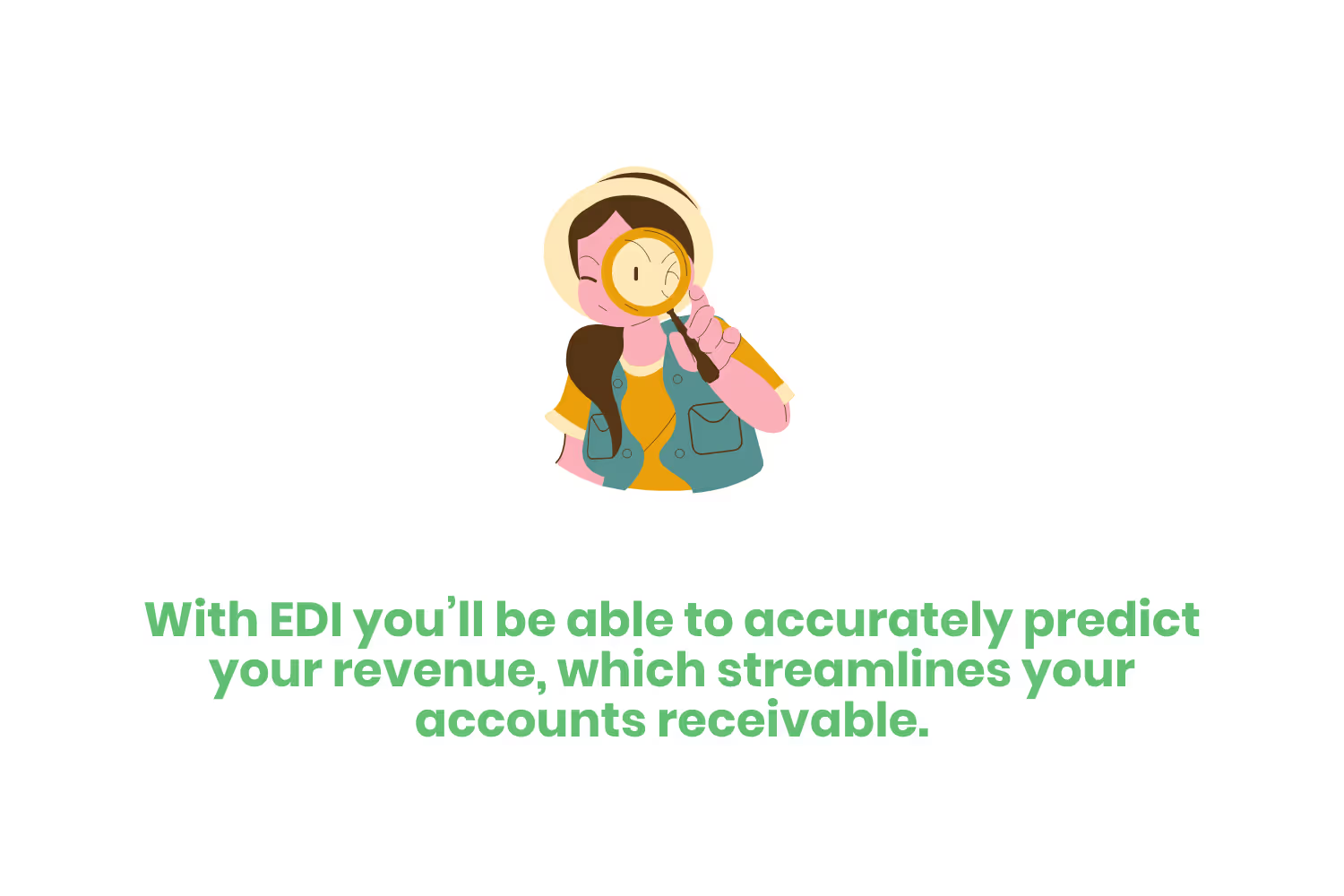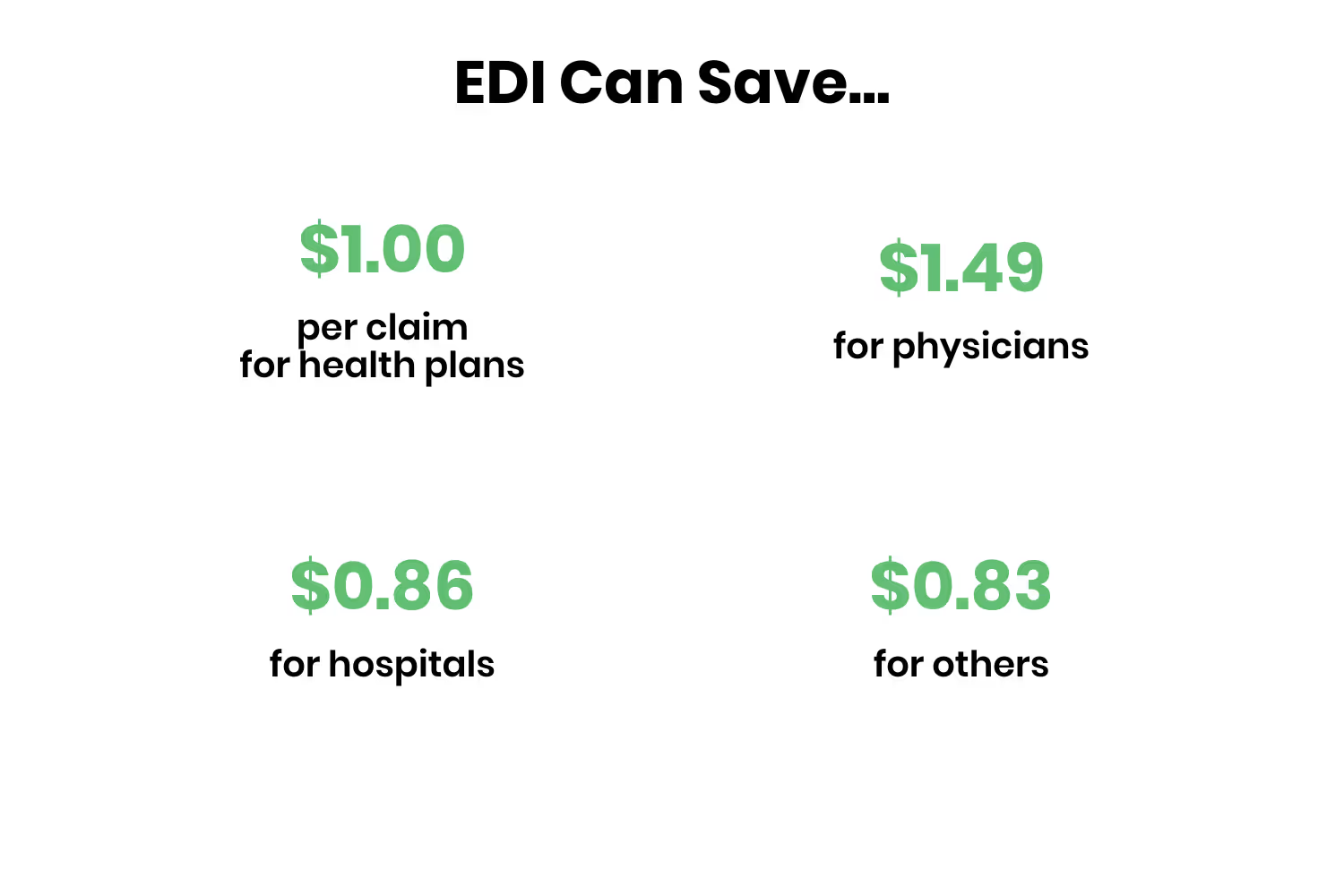12 Epic Electronic Data Interchange (EDI) Benefits
If the EDI industry has a value of nearly $2 billion, there has to be some additional perks associated with it. The short answer is yes. But, let’s take a look at the 12 biggest benefits of EDI.

EDI stands for Electronic Data Interchange.
It's used in a variety of industries from healthcare to supply chain and logistics. In the healthcare industry, EDI helps doctors communicate with insurance companies, government entities like Medicare, and the patients themselves.

EDI first started in the 1960s because there were more than 400 different types of standards. All of these standards created problems, like conversion errors, poor interoperability, security gaps, and high costs.
When healthcare entities implemented EDI, they were able to solve these issues. EDI helps them ensure quick and smooth data transmission and interpretation.
But, that can’t be the only benefit, right? If the EDI industry has a value of nearly $2 billion, there has to be some additional perks associated with it. The short answer is yes. But, let’s take a look at the 12 biggest benefits of EDI.
Benefit 1: Automate Processes
With EDI, you no longer need human intervention to process claims. All of the processes involved with the revenue cycle become automated.
There are a few benefits to automation. For example, processes run 24/7 and document-relevant data only needs to go into your computer system once. This means that businesses like yours can avoid doubling your workload.
Additionally, automating paper-based tasks allows employees to concentrate on other things, making them more productive. Therefore automating claims means better productivity.
Benefit 2: Improve Planning Processes
Implementing EDI makes it possible for you to plan more efficiently and spend more time on more important, revenue-driving tasks.
Companies can better handle claims thanks to all of the information available with the help of EDI.
Benefit 3:Less Paperwork
Many industries rely on countless paper forms. Think of forms like onboarding, insurance information, or even HIPAA consent forms if you work within healthcare. Whenever one of these paper forms manually processes into a computer, there’s an increased risk of human error.
These forms can also get lost along the way. This adds unnecessary delays to logistics processes. In turn, this means less time spent on tedious tasks.

With EDI, the exchange of information is fully automated, so there’s no longer a need for paper copies.
If this doesn’t seem like a benefit in and of itself, think of it this way. Using less paper means you reduce CO2 emissions. This translates to you promoting corporate social responsibility. So you can say that by using EDI, you are being environmentally friendly.
Benefit 4: Reduce Human Error
As mentioned above, companies using EDI no longer have the burden of individual paper forms. Removing paper is a huge benefit since these papers are responsible for causing so many errors along your revenue cycle.
Using EDI means you only have to enter information into your system once. This allows users to get rid of manually retyping information from forms.
EDI also allows businesses to immediately notice and track claim errors. For example, a typo in the ICD 10 code would trigger an automated warning to a predefined user.
This said, EDI isn’t foolproof.
If you work in the healthcare space, you know all about how claim denials come back from payers all the time. EDI does make it easier to send appeal letters and denial resubmissions.
Benefit 5: Increase Business Efficiency
Speaking of human error, because EDI minimizes it, organizations benefit from increased efficiency. You can focus on more important value-adding tasks instead of medical and tedious activities.
EDI can also improve an organization's patient and doctor relationship because of faster insurance payments.
Benefit 6: More Transparency
Since EDI involves the electronic sending of data, you have more transparency over everything. You see, your system will allow you to send data to key business partners (like payers in healthcare).

In the healthcare world, this is a huge benefit. Being able to see the delivery and status of the insurance claims you send in real time. That means that you’ll be able to accurately predict your revenue, which streamlines your accounts receivable.
Benefit 7: Increase Customer Satisfaction
Let me expand on that thought. Implementing EDI translates to faster payments for services. In turn, this benefits businesses and their clients.
In a nutshell, using EDI enables a high level of accuracy, efficiency, and speed.
With the help of features like “track-and-trace”, doctors can receive updates in real-time on the status of their insurance reimbursement. This gives them peace of mind regarding their reimbursement.
Therefore, implementing EDI increases the amount of money added to your bottom line!
Benefit 8: Get a Handle on Your Processes
When you use EDI to process and double-check your claims, you also get access to information like the status of your claim. This helps you make better predictions regarding your bottom line.
You also end up saving money in the long run because you don’t have to go back manually to fix any errors.
It’s also possible for companies to use EDI to group information from different sources. These groups can then go into management dashboards, saving you more time!
Benefit 9: Receive Information in Real-Time
EDI makes real-time information more readily available. Exchanging information in real-time also becomes easier.
Companies that aren’t using EDI have to compile all of the relevant information together. This is not only unnecessary and laborious, but it is also time-consuming.
Benefit 10: Cut Costs
Companies that use EDI can see a positive impact on their bottom line. They can move faster and make better decisions thanks to the abundance of claim data.
Based on government estimates, EDI can save…
- $1 per claim for health plans
- $1.49 for physicians
- $0.86 for hospitals
- $0.83 for others
Think of the operating costs you could eliminate by removing the cost of paper, printing, reproduction, storage, filing, postage, and document retrieval!
In turn, this generates savings. Customers can then see savings themselves, thus improving the competitiveness of your organization!

Benefit 11: Improve Your Data Exchange
Let’s face it, data is king in today’s modern business world.
Let’s take a look at healthcare companies for example. These organizations work with huge amounts of data. In this industry, numerous people and companies are working together to reimburse doctors for their services. Each party is responsible for reimbursing some portion of a doctor’s bill.
Automatically exchanging information with the help of EDI means logistics processes can happen faster with more accuracy and at a more cost-effective price point.
Benefit 12: Enhance Transaction Security
EDI enhances the security of transactions and documents by securely sharing data across a network. After all, you need to protect any PHI and personally identifiable information.
It uses a wide variety of communication protocols and security standards, such as the ASC X12.
Conclusion
One industry that processes an enormous amount of data is the healthcare space.
Healthcare processes documents like patient medical records, health insurance reimbursements, and healthcare claims.
Using paper is cumbersome. It’s inefficient and expensive. This is why the government responded to healthcare claims with the creation of EDI.
EDI is very complicated. Many parts of it are confusing. But there are so many benefits that outweigh the confusion. It helps simplify the process of organizing and sending documents from healthcare providers to other parties.
Emphasize your product's unique features or benefits to differentiate it from competitors
In nec dictum adipiscing pharetra enim etiam scelerisque dolor purus ipsum egestas cursus vulputate arcu egestas ut eu sed mollis consectetur mattis pharetra curabitur et maecenas in mattis fames consectetur ipsum quis risus mauris aliquam ornare nisl purus at ipsum nulla accumsan consectetur vestibulum suspendisse aliquam condimentum scelerisque lacinia pellentesque vestibulum condimentum turpis ligula pharetra dictum sapien facilisis sapien at sagittis et cursus congue.
- Pharetra curabitur et maecenas in mattis fames consectetur ipsum quis risus.
- Justo urna nisi auctor consequat consectetur dolor lectus blandit.
- Eget egestas volutpat lacinia vestibulum vitae mattis hendrerit.
- Ornare elit odio tellus orci bibendum dictum id sem congue enim amet diam.
Incorporate statistics or specific numbers to highlight the effectiveness or popularity of your offering
Convallis pellentesque ullamcorper sapien sed tristique fermentum proin amet quam tincidunt feugiat vitae neque quisque odio ut pellentesque ac mauris eget lectus. Pretium arcu turpis lacus sapien sit at eu sapien duis magna nunc nibh nam non ut nibh ultrices ultrices elementum egestas enim nisl sed cursus pellentesque sit dignissim enim euismod sit et convallis sed pelis viverra quam at nisl sit pharetra enim nisl nec vestibulum posuere in volutpat sed blandit neque risus.

Use time-sensitive language to encourage immediate action, such as "Limited Time Offer
Feugiat vitae neque quisque odio ut pellentesque ac mauris eget lectus. Pretium arcu turpis lacus sapien sit at eu sapien duis magna nunc nibh nam non ut nibh ultrices ultrices elementum egestas enim nisl sed cursus pellentesque sit dignissim enim euismod sit et convallis sed pelis viverra quam at nisl sit pharetra enim nisl nec vestibulum posuere in volutpat sed blandit neque risus.
- Pharetra curabitur et maecenas in mattis fames consectetur ipsum quis risus.
- Justo urna nisi auctor consequat consectetur dolor lectus blandit.
- Eget egestas volutpat lacinia vestibulum vitae mattis hendrerit.
- Ornare elit odio tellus orci bibendum dictum id sem congue enim amet diam.
Address customer pain points directly by showing how your product solves their problems
Feugiat vitae neque quisque odio ut pellentesque ac mauris eget lectus. Pretium arcu turpis lacus sapien sit at eu sapien duis magna nunc nibh nam non ut nibh ultrices ultrices elementum egestas enim nisl sed cursus pellentesque sit dignissim enim euismod sit et convallis sed pelis viverra quam at nisl sit pharetra enim nisl nec vestibulum posuere in volutpat sed blandit neque risus.
Vel etiam vel amet aenean eget in habitasse nunc duis tellus sem turpis risus aliquam ac volutpat tellus eu faucibus ullamcorper.
Tailor titles to your ideal customer segment using phrases like "Designed for Busy Professionals
Sed pretium id nibh id sit felis vitae volutpat volutpat adipiscing at sodales neque lectus mi phasellus commodo at elit suspendisse ornare faucibus lectus purus viverra in nec aliquet commodo et sed sed nisi tempor mi pellentesque arcu viverra pretium duis enim vulputate dignissim etiam ultrices vitae neque urna proin nibh diam turpis augue lacus.



![[ANSWERED] What is a Long-Term Care (LTC) Pharmacy](https://cdn.prod.website-files.com/67e2b8210878abcba6f91ae6/68d687806a075a1cf64659b0_WhatisLongTermCarePharmacy_925.avif)
